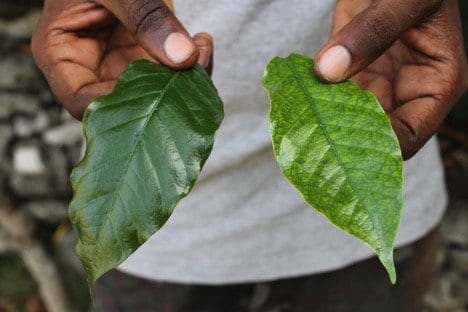
Most of us have never had coffee from Haiti ”what does coffee production look like, and how do farmers deal with the ups and downs of an unpredictable crop?
Once a leader in coffee production, Haiti hasn’t been on the coffee map for decades. Political unrest and natural disasters have cut the once thriving industry to a fraction of what it once was, and most of it never makes it to the hands and cups of specialty coffee shops. Writer Mika Cohen decided to learn more about coffee in Haiti, and shares her travel experiences below.
BY MIKA COHEN
SPECIAL TO BARISTA MAGAZINE
Haiti is an overwhelming experience for the unseasoned traveler. Travel to Haiti is nothing more than a plane ride, but travel in Haiti is another ordeal entirely. My goal for this adventure was to talk to real coffee farmers, in their hometowns and hear their stories. I had no idea the journey would be as incredible as the destination.
My guide, Ansly, took me to Thiotte, his hometown. First we took a tap-tap ”a brightly colored bus packed tightly with people ”from Port-au-Prince to Croix-des-Bouquets (pronounced Kwa-de-Bouquet), the art district. We arrived at a transit depot, which was nothing more than an abandoned gas station, right in the middle of town. There were several large trucks that are designed to carry agricultural products, not people.

School is out so it’s busy, loud, and a little intimidating. I waited inside the depot, which had been turned into a bar, while Ansly secured a spot in the cab of a truck carrying about 50 people and several chickens in the back. We loaded up and sped down the road towards the Dominican border until we made a hard right and headed down a dirt and rock road toward the mountains. The road remained rocky, bumpy, and difficult for the five-hour trip. We passed dangerously close to a ravine and saw several open air markets along the way, and watched as women washed clothes and children bathed in the milky river.
After making our way through a blue pine forest, we arrived in Thiotte, a mountain town known for its coffee production and fresh air. It was cooler there. We grabbed a bite to eat at a local restaurant that had only fried bananas, pikliz (pickled vegetables), and some fried meats to give us. At dusk, we hopped on the back of a moto (motorcycle taxi) and made our way to the Dominique Hotel. A cold tile floor and low lights greeted us, along with our own echoes.

In the morning, Ansly took me out into the garden of the Dominique, which hosted a variety of flowers, fruit trees, and coffee trees. This was my very first time seeing a live coffee tree with real coffee berries. I was in awe. A man and several women were working the garden. Ansly, being from Thiotte, was very comfortable here and approached the young man so that we could ask him some questions. He was soft spoken and polite.
Dieubon (meaning ˜God is Strong’) is 23 and started farming coffee when he couldn’t find a job after graduating school. He enjoys his work but dreams of becoming an electrician, and hopes to return to school to pursue that dream. Such, I found, is the story with many farmers in the region. Either they love the income and freedom that coffee provides, or this is how they earn a living until jobs become available. It is a challenging and rewarding lifestyle, and I am profoundly grateful to have travelled the tough road to Thiotte for the reward of experiencing its people and its magnificent coffee trees.

After photographing the beautiful garden, Ansly and I grabbed a moto outside the Dominique and took the 20-minute ride to Coopcab. Upon arriving, we entered a small front office with a table set with tiny ceramic cups and a coffee thermos, just for visitors to sample their coffee. In Haiti, coffee is consumed black, with a small amount of sugar. Milk isn’t easily refrigerated nor widely available. This preparation cuts the bitterness without distracting from the flavor of the coffee itself. Because my visit to Coopcab wasn’t planned, we were greeted with a bit of skepticism. Jean Osier, who is in charge of quality control, agreed to give us a tour after a bit of discussion and me clarifying exactly what my intentions were.
We started with a history lesson. Coopcab was founded in 1999 as a œ2nd degree co-op, meaning it is made of 10 smaller local farming organizations, with members totaling about 6,000. Coopcab’s purpose is to encourage farmers to produce quality beans by paying fair wages, finding buyers, processing, and profit sharing. There are five board members and a general assembly made up of three members of each organization to ensure all voices are heard fairly.

Quality control is their top priority. Several machines are involved in sizing and sorting the beans, which are categorized by what organization they are from. At the final stage, the beans are picked through by hand. Jean Osier is very proud of this process, and shows me a handful of the sorted beans as proof of their obsession with quality. After being exposed to the incredible aroma, I purchased a couple bags of coffee right there. I chose the Mare Blanche, which is roasted to a chocolaty color and has floral, citrus, caramel, and chocolate notes.
For a different perspective, Ansly then took me to visit his father, Paul Andre Pierre, an independent coffee farmer in the region. We sat on the porch of a general store with Pierre and his friend Paul Elie. Pierre loves his work and the financial opportunity it provides, but is more and more discouraged lately because of the woui ”rouille in French, rust in English. It seems that coffee rust on is getting worse, and these farmers don’t have the resources to battle it. Production is declining, and they are being forced to choose a lesser quality strain which is resistant to the woui.
The entire region relies solely on rain for fresh water. There are no flowing rivers or lakes. They are provided water only œwhen God gives it. Still, with the woui becoming worse year over year, Pierre says that if they don’t find a solution, he will simply give up. Small farmers like him are in trouble.

During our brief discussion about the future of coffee production in Thiotte, a younger gentleman approached the porch where we were sitting and asked what this blan (foreigner) is doing here. Ansly kindly explained my curiosity with coffee, and he immediately opened up about woui and what it’s doing to the region. œYou’re also a coffee farmer? I asked. œWi, he replied. Then, in Kreyol he asked Ansly, œMaybe she can find someone to help us? All I could do was say, œI’ll try. I would love to help.
 Mika Cohen is a world traveler based in St. Louis, MO. Her passion, coffee, is more than just the way she stays caffeinated. It’s a catalyst she uses to bring awareness to the differences and similarities of cultures around the globe. Say hi and share a virtual cup of joe on Instagram or via email.
Mika Cohen is a world traveler based in St. Louis, MO. Her passion, coffee, is more than just the way she stays caffeinated. It’s a catalyst she uses to bring awareness to the differences and similarities of cultures around the globe. Say hi and share a virtual cup of joe on Instagram or via email.

